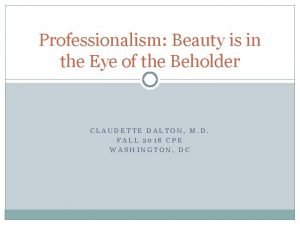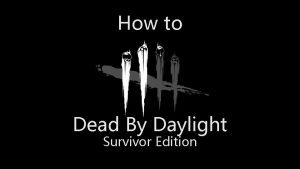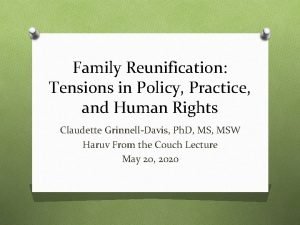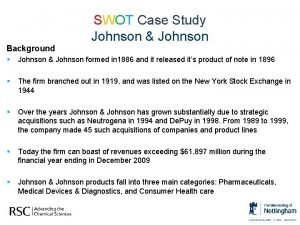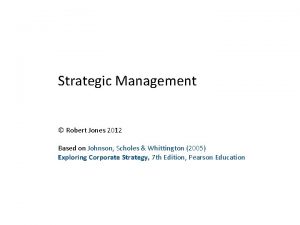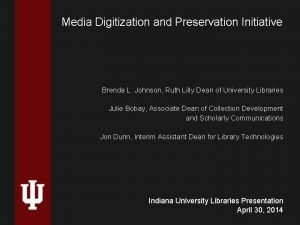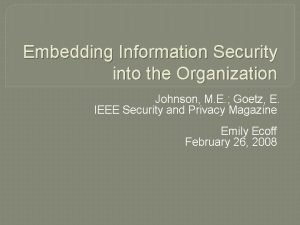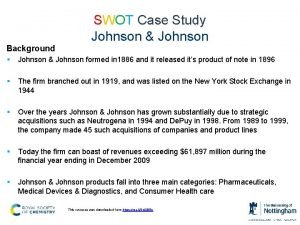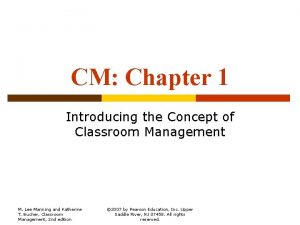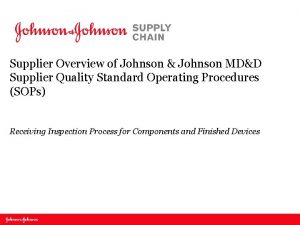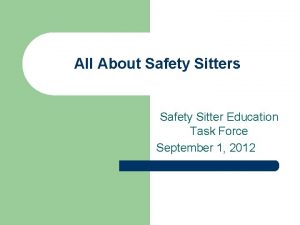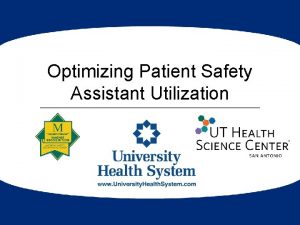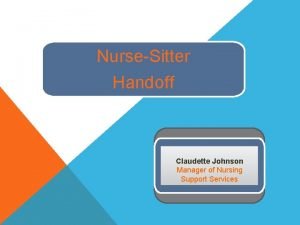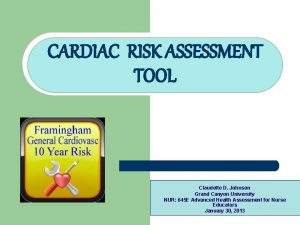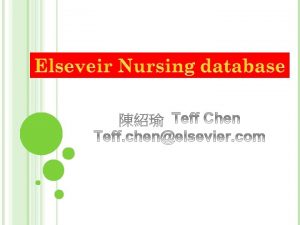Safety Sitter Education Claudette Johnson Manager of Nursing


















- Slides: 18

Safety Sitter Education Claudette Johnson Manager of Nursing Support Services

CONTINUOUS OBSERVATION Provide a safe environment for patients whose physiological, mental and behavioral status puts them at risk of harming self and others. Used for patients: suicide, 5 point restraints & behavioral risk

ROLE OF OBSERVATION ASSISTANT Monitor patient behavior & safety Provide safe environment Provide reassurance and redirection Prevent Falls and Injury Keep patient: safe, engaged, in control, dignified

OBSERVATION ASSISTANT DOS AND DON’T CAN NOT Ø Ambulate steady gait patients Ø Ambulate unsteady patients Ø Set up trays Ø Feed patients Ø Unplug IMEDS only if directed by Nurse Ø Touch IMEDS without nurses' direction Ø Talk and calm patient down Ø Hold a patients arm down (staff should use mitts or medicate patient) Know that PCTs who are sitting can provide PCT care. The nurse will need to update sitter for any changes. Sitters will be passing information to each other

REASON FOR CHANGE Patient safety Utilize OA efficiently Cost effectiveness Focus on patient recovery Therapeutic presence

BENEFITS Keep patient safe Keep patient and family engage Keep patient in control Facilitate patient Recovery Utilizing OA efficiently

WHO WILL BENEFIT Family Staff PATIENT

HANDOFF INEFFECTIVE STAKEHOLDERS Staff HANDOFFS Wrong treatment Delay in Diagnosis Adverse events Patient dissatisfaction Patient Increase hospital cost Leadership Increase length of stay

RESOURCES Human factor Time constraints Volume of Information Confidentiality Limited training Gaps in communication

COMMON HANDOFF ISSUES CAUSES OF FAILURE CAUSES OF SUCCESS Ineffective Methods Open to change Time constraints Understand purpose of Change Preparedness and education Lack of focused research on healthcare and handoff Commitment to making a difference Lack of Efficiency Management Support Lack of commitment

IMPLEMENTATION v Up-to-date information on the following: Diagnosis, Care, Condition and Changes v. Limited interruptions v. Sufficient time allocated v. Process for verification- repeat back read back

NURSE-SITTER TOOL Purpose to improve safety as well as patient and staff satisfaction. Patient: Room # _____ Date ____Shift______ Hand off information for any sitter will include: What is wrong with patient? ______________ Why do they need a sitter? _______________ Diet/ fluid restrictions: _________________ Activity- independent or with assist ___________ Specifics about their care _______________ Time for their meal breaks, what time they are expected back - SPECIFIC TIME ____________________ Who will relieve them for their break? __________ Phone number: Charge: Break Relief: ______ OA/PCT Signature: ________ Date: ______

SITTER HANDOFF GUIDELINES Hand off information for any sitter staff will include: 1) What is wrong with patient? Why is a sitter needed? (Hip replacement but is sun downing tries to get out of bed after 7 pm) 2) Diet/ fluid restrictions (NPO, 1 cup of water every shift) 3) Activity- independent or not (can get up by himself, can get up safely with walker) 4) Specifics about their care (examples: quick with hands must watch IV or Foley, bolts out of bed, confused, watch for visitors) 5) Time for their meal breaks, what time expected back -MUST be a SPECIFIC TIME (not 1 hour from now but instead 0445) 6) Who will relieve sitter for their break (Julie, PCT and her phone # is____) - OA for suicides have to watch the patient at all times and should not be standing by the door looking for help.

WHAT IS ASSERTIVENESS IT IS NOT… Aggressive Ridiculing Ambiguous Hostile Confrontational

PILOT STUDY Begins February 08 to March 08, 2011 Forms available in the Float Pool room Send completed sheets to Claudette Johnson Questions: call Claudette at x. 7959

Survey to assess the success of the PILOT STUDY Survey For: all OAs random RN/ PCT Deadline: October 1, 2011 Return to: Claudette Johnson 3 W

Change For Safety And more importantly, change for our Patient

REFERENCES Agency for Healthcare Research and Quality (2005). 30 safe practices for better health care: Fact sheet. Retrieved March 19, 2011, from http: //www. ahrq. gov/qual/30 safe. htm Institute of Medicine. Committee on Quality Health Care in America. (2000). Errors in health care: A leading cause of death and injury. In L. Kohn, J. Corrigan, & M. Donalsdson (Eds. ) To Err Is Human: Building a Safer Health System. Washington, D. C: National Academy Press. Joint Commission on Accreditation of Healthcare Organizations. (2008). 2009 national patient safety goals [electronic version]. Joint Commission Perspectives, 28(7), 12. Retrieved March 19, 2011, from http: //www. jcrinc. com/common/PDFs/fpdfs/pubs/pdfs/JCReqs/JCP-07 -08 -S 1. pdf Northwest Community Hospital (NCH), (2011). Nurse- Sitter handoff tool. Nothwest Community Hospital. (2011). Pre-assessment of sitter needs survey.
 Claudette dalton md
Claudette dalton md Claudette morel bloodweb
Claudette morel bloodweb Claudette grinnell-davis
Claudette grinnell-davis Johnson and johnson swot analysis
Johnson and johnson swot analysis Johnson and johnson bcg matrix
Johnson and johnson bcg matrix Laurie johnson brad johnson
Laurie johnson brad johnson Johnson and johnson values
Johnson and johnson values Johnson and johnson organizational structure
Johnson and johnson organizational structure Understanding the mirai botnet
Understanding the mirai botnet Swot johnson and johnson
Swot johnson and johnson Jjeds employee directory
Jjeds employee directory Dreikurs classroom management theory
Dreikurs classroom management theory Johnson and johnson md&d
Johnson and johnson md&d Musevisa chords
Musevisa chords Penrose diagram de sitter
Penrose diagram de sitter De sitter space
De sitter space Patient sitter algorithm
Patient sitter algorithm Patient safety assistant
Patient safety assistant Medge taivutus
Medge taivutus
